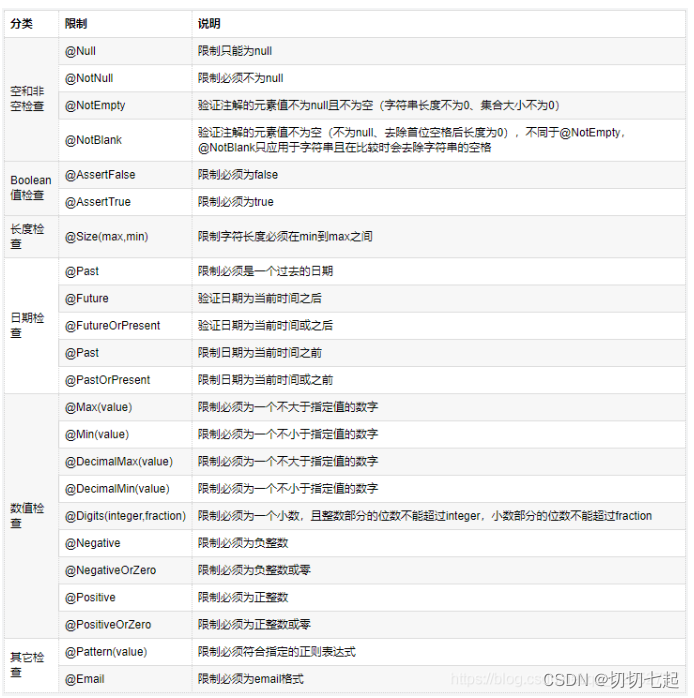一.SpringBoot不常用注解
1. @ImportResource(locations = "classpath:applicationContext.xml")
locations = 指定targer目录下配置文件的位置注解是用在启动类上面,表示在SpringBoot启动的时候加载指定的配置文件
@Resource //自动注入
2. @EnableConfigurationProperties({StudentProperties.class, AddressProperites.class})用在SpringBoot启动类上面,注解里面的参数是class类型的数组,作用是:启动的时候让指定的类放进Spring容器中,或者在每个类上面加入@Component注解
3. @PropertySource(value = "classpath:db.properties") //参数是指定targer目录下配置文件的位置一般用于pojo实体类上面,当项目启动的时候加载指定的配置文件,默认加载application.yml文件和@ConfigurationProperties(prefix = "jdbc.mysql"),连用表示加载classpath:db.properties文件并且把jdbc.mysql开头的属性赋值给实体类上面的成员变量
4. @Data //用在pojo实体类上表示开启get、set、tostring方法等
5. @NoArgsConstructor //用在pojo实体类上表示开启无参构造 @AllArgsConstructor //用在pojo实体类上表示开启有参构造
6. @Accessors(chain = true) //用在pojo实体类上面开启对象中方法的链式调用
7. @Slf4j //用在controller类上面注解式日志
8. @DateTimeFormat(pattern = "yyyy-MM-dd") //用在成员变量上接收参数时候日期格式化
9. @Repository //用在dao层@Repository和@Controller、@Service、@Component (用于其他) 的作用差不多,都是把对象交给spring管理。@Repository用在持久层的接口上,这个注解是将接口的一个实现类交给spring管理。
10. @Mapper //用在dao层接口上将当前标注接口生成Mapper代理对象,并将代理对象放入IOC容器中
11. @MapperScan(basePackages = {"com.bjpowernode.dao", "com.bjpowernode.dao2"})
用在启动类上面扫描指定包下所有的mappr接口放入IOC容器中
12.@Validated //作用在类、方法和参数上,是一套帮助我们继续对传输的参数进行数据校验的注解,通过配置Validation可以很轻松的完成对数据的约束。

@Pattern(regexp = "^[1-9][0-9]{6,9}@[a-zA-Z0-9]{1,4}.[a-zA-Z0-9]{1,4}$",message = "邮箱格式不正确") //正则表达式
如果一个类中包含了另外一个实体类,那么在上面加上@Validated即可,比如上面的:
public class XoPO {
@validated
private List<PersonDetailPO> personList;
}
@NotNull 数据不能为null @NotEmpty 数据不能为null,不能为空字符串 @NotBlank 数据不能为null,不能为空字符串,不能由空白字符组成 @Size 校验数据、集合、字符串的长度 @Range 数组范围校验 @Email 邮箱校验 @Pattern(regexp="", message = "") 正则校验 通用配置项:message 校验失败时的提示信息
13. Aop
@Aspect:作用是把当前类标识为一个切面供容器读取
@Pointcut:Pointcut是植入Advice的触发条件。每个Pointcut的定义包括2部分,一是表达式,二是方法签名。方法签名必须是 public及void型。可以将Pointcut中的方法看作是一个被Advice引用的助记符,因为表达式不直观,因此我们可以通过方法签名的方式为 此表达式命名。因此Pointcut中的方法只需要方法签名,而不需要在方法体内编写实际代码。
@Around:环绕增强,相当于MethodInterceptor
@AfterReturning:后置增强,相当于AfterReturningAdvice,方法正常退出时执行
@Before:标识一个前置增强方法,相当于BeforeAdvice的功能,相似功能的还有
@AfterThrowing:异常抛出增强,相当于ThrowsAdvice
@After: final增强,不管是抛出异常或者正常退出都会执行
@Pointcut, 定义一个切面,即上面注解中的一个入口切入点定义了时间触发时机
用法:
@Component
@Aspect
// @Order
public class AopAspect {
@Pointcut("execution(* com.bjpowernode.controller.*.*(..))")
public void exp(){}
public static final String POINT_CUT = "execution(* com.bjpowernode.controller.*.*(..))";
/**
* 前置通知
*/
@Before("exp()")
public void before(){
System.out.println("切面前置通知...");
}
/**
* 后置通知
*/
@After(POINT_CUT)
public void after(){
System.out.println("切面后置通知...");
}
/**
* returning = "result" 定义返回值参数
* 返回通知
*/
@AfterReturning(value = POINT_CUT, returning = "result")
public void returning(Object result){
System.out.println("切面返回通知..." + result);
}
/**
* throwing = "ex" 定义异常参数
* 异常通知
*/
@AfterThrowing(value = POINT_CUT, throwing = "ex")
public void throwing(Exception ex){
System.out.println("切面异常通知..." + ex.getMessage());
}
}14. Swagger
@Api(tags = "学生接口") 用在请求的类上,表示对类的说明
@ApiOperation("分页条件查询学生信息") 对某个方法/接口进行描述
@ApiImplicitParams({ @ApiImplicitParam(name = "pageNumber", value = "当前页码", required = false, dataType = "Integer", defaultValue = "1", paramType = "query"), @ApiImplicitParam(name = "pageSize", value = "每页条数", required = false, dataType = "Integer", defaultValue = "10", paramType = "query") })
@ApiResponses({ @ApiResponse(code = 0, message = "成功"), @ApiResponse(code = -1, message = "失败") })
示例:
@RestController
@RequestMapping("/student")
@Api(tags = "学生接口")
public class StudentController {
@GetMapping("/page")
@ApiOperation("分页条件查询学生信息")
@ApiImplicitParams({
@ApiImplicitParam(name = "pageNumber", value = "当前页码", required = false, dataType = "Integer", defaultValue = "1", paramType = "query"),
@ApiImplicitParam(name = "pageSize", value = "每页条数", required = false, dataType = "Integer", defaultValue = "10", paramType = "query")
})
@ApiResponses({
@ApiResponse(code = 0, message = "成功"),
@ApiResponse(code = -1, message = "失败")
})
public Result page(@RequestParam(value = "pageNumber", defaultValue = "1") Integer pageNumber,
@RequestParam(value = "pageSize", defaultValue = "10") Integer pageSize,
Student student){
System.out.println(pageNumber);
System.out.println(pageSize);
System.out.println(student);
return Result.success();
}
@GetMapping("/get/{id}")
@ApiOperation("根据ID查询学生信息")
@ApiImplicitParam(name = "id", value = "学生编号", required = true, dataType = "Integer", paramType = "path")
public Result get(@PathVariable("id") Integer id){
System.out.println(id);
return Result.success();
}
@PostMapping("/save")
@ApiOperation("新增学生信息")
public Result save(@RequestBody Student student){
System.out.println(student);
return Result.success();
}
@PutMapping("/update")
@ApiOperation("编辑学生信息")
public Result update(@RequestBody Student student){
System.out.println(student);
return Result.success();
}
@DeleteMapping("/remove/{id}")
@ApiOperation("根据ID删除学生信息")
@ApiImplicitParam(name = "id", value = "学生编号", required = true, dataType = "Integer", paramType = "path")
public Result remove(@PathVariable("id") Integer id){
System.out.println(id);
return Result.success();
}
}解释:
@Api:用在请求的类上,表示对类的说明
tags="说明该类的作用,可以在UI界面上看到的注解"
value="该参数没什么意义,在UI界面上也看到,所以不需要配置"
@ApiOperation:用在请求的方法上,说明方法的用途、作用
value="说明方法的用途、作用"
notes="方法的备注说明"
@ApiImplicitParams:用在请求的方法上,表示一组参数说明
@ApiImplicitParam:用在@ApiImplicitParams注解中,指定一个请求参数的各个方面
name:参数名
value:参数的汉字说明、解释
required:参数是否必须传
paramType:参数放在哪个地方
· header --> 请求参数的获取:@RequestHeader
· query --> 请求参数的获取:@RequestParam
· path(用于restful接口)--> 请求参数的获取:@PathVariable
· body(不常用)
· form(不常用)
dataType:参数类型,默认String,其它值dataType="Integer"
defaultValue:参数的默认值
@ApiResponses:用在请求的方法上,表示一组响应
@ApiResponse:用在@ApiResponses中,一般用于表达一个错误的响应信息
code:数字,例如400
message:信息,例如"请求参数没填好"
response:抛出异常的类
@ApiModel:用于响应类上,表示一个返回响应数据的信息
(这种一般用在post创建的时候,使用@RequestBody这样的场景,
请求参数无法使用@ApiImplicitParam注解进行描述的时候)
@ApiModelProperty:用在属性上,描述响应类的属性@ApiModel("学生实体") //对该接口相关实体类添加额外的描述信息
@ApiModelProperty("学生ID") //对该接口相关实体类添加额外的描述信息
用法:
@ApiModel("学生实体")
public class Student {
@ApiModelProperty("学生ID")
private Integer id;
@ApiModelProperty("学生姓名")
private String name;
@ApiModelProperty("学生地址")
private String address;
@ApiModelProperty("学生生日")
private Date birthday;
}
14 @Transactional(rollbackFor = Exception.class) //添加事务,作用在类或方法上默认回滚运行异常
15 @Scheduled(cron = "0/5 * * ? * 1-7") // 用在方法上
用这个注解的时候启动类上面要添加
@EnableScheduling //开启定时任务
/** * 定时任务注解 @Scheduled cron为定时表达式 * 秒 分 时 日 月 周 年(可选) * *星号:表示每,每秒,每分.... * ?问好:只能在日期和星期两个位置出现,排除冲突 * -中划线:表示一个范围 * ,逗号:表示一个列表值,比如在星期中使用 1,2,4 */
16 @Async //标记的异步的方法方法上一旦标记了这个方法,当其它线程调用这个方法时,就会开启一个新的线程去异步处理业务逻辑。 上面的配置会启用默认的执行器,异步执行指定的方法。 在业务场景中,有时需要使用自己定义的执行器来跑异步的业务逻辑,那该怎么办呢? 1、 @Async 注解由于是异步执行的,在其调用数据库操作之时,将无法产生事务管理的控制。 解决办法,可以把@Transactional注解放到内部的需要进行事务的方法上
用这个注解的时候启动类上面要添加,
@EnableAsync //开启异步调用
16 redis
@EnableCaching //用在redis配置类上面
@CachePut(cacheNames = CommonsUtil.USER_LOGIN_CACHE, key = "#username", unless = "#result == null")
作用:向redis中存放数据,缓存的值为当前方法的返回值
@Cacheable(cacheNames = CommonsUtil.USER_LOGIN_CACHE, key = "#username", unless = "#result == null")
作用:根据指定key获取redis对应的value,如果在redis查找不到对应value值,就会执行方法,将方法的返回值存储到redis中
@CacheEvict(cacheNames = CommonsUtil.USER_LOGIN_CACHE, key = "#username")
作用:清除缓存
@CacheEvict(cacheNames = CommonsUtil.USER_LOGIN_CACHE, allEntries = true)
批量删除缓存:根据缓存的前缀(缓存空间)删除多个缓存
示例:
package com.bjpowernode.serivce;
import com.bjpowernode.bean.User;
import com.bjpowernode.commons.CommonsUtil;
import org.springframework.cache.annotation.CacheEvict;
import org.springframework.cache.annotation.CachePut;
import org.springframework.cache.annotation.Cacheable;
import org.springframework.stereotype.Service;
@Service
public class UserService {
/**
* @CachePut
* 作用:向redis中存放数据
* 缓存的值为当前方法的返回值
* redis中的键 = 配置项cacheNames + 配置项key
*
* 配置项:
* cacheNames/value 缓存空间,缓存键的前缀,是属于键中的固定部分,所以指定字符串
* key 缓存键中动态部分,其中不能使用固定字符串,需要使用表达式来实现
* 表达式:
* #result 表示当前方法的返回值对象
* #当前方法参数名(推荐使用)
* #root.args 表示当前方法的参数列表(数组)
* #root.args[0] 表示当前方法的第一个参数 #a0 #p0
* #root.methodName表 示当前方法的名称
* unless/condition 存储条件,其中必须使用表达式
*
*/
@CachePut(cacheNames = CommonsUtil.USER_LOGIN_CACHE, key = "#username", unless = "#result == null")
public User login(String username, String password){
//模拟登录
return new User(1000, username, password);
// return null;
}
/**
* @Cacheable
* 作用:根据指定key获取redis对应的value,如果在redis查找不到对应value值,就会执行方法,将方法的返回值存储到redis中
*
* 如果只想实现查询的功能,方法返回值为null,并配置存放条件为null值不存储
*/
@Cacheable(cacheNames = CommonsUtil.USER_LOGIN_CACHE, key = "#username", unless = "#result == null")
public User getUser(String username){
System.out.println("getUser.....");
return new User(111, username, null);
}
/**
* @CacheEvict
* 作用:清除缓存
*/
@CacheEvict(cacheNames = CommonsUtil.USER_LOGIN_CACHE, key = "#username")
public void removeUser(String username){
System.out.println("删除缓存...");
}
/**
* 批量删除缓存:根据缓存的前缀(缓存空间)删除多个缓存
*/
@CacheEvict(cacheNames = CommonsUtil.USER_LOGIN_CACHE, allEntries = true)
public void removeUserAll(){
System.out.println("删除全部缓存...");
}
}17Test模块注解
@RunWith(SpringJUnit4ClassRunner.class),让测试运行于Spring测试环境 @SpringBootTest(classes = SpringbootElasticsearchApp.class),配置Test模块上面的启动类
二.Mybatis-Plus
前提
service层继承IService<实体类类型>类
serviceImpl继承ServiceImpl<持久层接口类型, 实体类类型>类
dao层继承BaseMapper<实体类类型>类
@TableName 描述:表名注解,标识实体类对应的表 使用位置:实体类
@TableId 描述:主键注解 使用位置:实体类主键字段
@TableField 描述:字段注解(非主键)
@TableLogic 描述:表字段逻辑处理注解(逻辑删除) 实体类成员变量
示例:
@Data
@Accessors(chain = true)
@TableName("tab_user")
public class User {
/**
* type = IdType.ASSIGN_ID 默认值,表示当前主键值由MybatisPlus生成,采用雪花算法
* IdType.AUTO MybatisPlus不再生成主键,而是由数据库生成
*/
@TableId(value = "id", type = IdType.ASSIGN_ID)
private String userId;
private String name;
private Integer age;
@TableField("email")
private String userEmail;
private String gender;
//扩容属性,关联属性
//表示当前属性在表中没有对应字段
@TableField(exist = false)
private String genderName;
//标识当前属性对应的逻辑删除标志字段
@TableLogic
private String delFlag;
}三.SpringSecurity
@EnableWebSecurity SpringSecurity5.0版本之后,无需配置此注解
@EnableGlobalMethodSecurity(prePostEnabled = true) 开启权限使用注解,配置类或启动类上使用
@PreAuthorize @PreAuthorize 在方法调用前进行权限检查
示例:
// 角色检查
@PreAuthorize("hasRole('ADMIN')")
@GetMapping("/admin/query")
public String adminQuery(){
return "admin-query";
}
// 权限检查
@PreAuthorize("hasAuthority('sys:query')")
@GetMapping("/query")
public String query(){
return "系统查询";
}@JsonIgnore json忽略:在进行json字符串转换时忽略此方法
示例:
/**
* json忽略:在进行json字符串转换时忽略此方法
*/
@JsonIgnore
public String getPassword() {
return this.userpwd;
}四.Dubbo
@EnableDubbo 开启dubbo注解扫描
示例:
@SpringBootApplication
@EnableDubbo//开启dubbo注解扫描
public class DubboxProviderApp {
public static void main(String[] args) {
SpringApplication.run(DubboxProviderApp.class,args);
}
}@Reference 从zookeeper中找对应的Service类
示例:
@RestController
public class HelloController {
//@Autowired//从ioc容器中找HelloService
@Reference//从zookeeper中找HelloService
private HelloService helloService;
@RequestMapping("/hello")
public String hello(){
System.out.println(helloService.getClass()+"----------------");
return helloService.hello();
}
}五.SpringCloudaAlibaba
@EnableDiscoveryClient 向注册中心注册该服务,并可以获取其他服务的调用地址
作用在启动类上
示例:
@SpringBootApplication
@EnableDiscoveryClient
public class NacosConfigApp {
public static void main(String[] args) {
SpringApplication.run(NacosConfigApp.class,args);
}
}@RefreshScope 修改配置文件后则重新生成bean,nacos配置文件不用重启实时更新
@LoadBalanced 开启ribbon的负载均衡默认是轮循方式,用于配置类的RestTemplate的方法上
示例:
@Configuration
public class ConfigBean {
/**
* 发送rest请求的工具类
* @return
*/
@Bean
@LoadBalanced //开启ribbon负载均衡,默认时轮询策略
public RestTemplate restTemplate(){
return new RestTemplate();
}
//随机方式
@Bean
public IRule iRule(){
return new RandomRule();
}
}@EnableFeignClients 开启feign注解的扫描 用于consumer启动类上面
@FeignClient("服务名字") 获取服务提供者对象用在feign接口上
六、事务
@Transactional(rollbackFor = Exception.class) //添加事务,作用在类或方法上默认回滚运行异常
@GlobalTransactiona //服务调用服务的时候使用,与传统的事务并不冲突




















 2017
2017











 被折叠的 条评论
为什么被折叠?
被折叠的 条评论
为什么被折叠?








